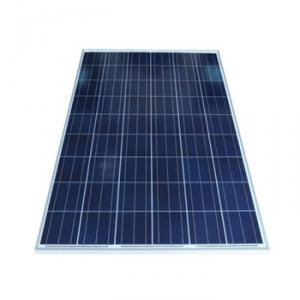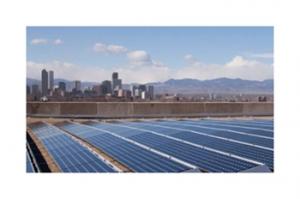Tesla Solar Inverter Compatible Poly-Crystalline 220W 156*156 Solar Modules
- Loading Port:
- China Main Port
- Payment Terms:
- TT or LC
- Min Order Qty:
- -
- Supply Capability:
- -
OKorder Service Pledge
OKorder Financial Service
You Might Also Like
Solar Module Descriptions:
Solar Power Modules (known as Photovoltaics - PV) can generate electricity for your home or business, either as part of a stand-alone solar power system, or for buildings already connected to the local electricity network.
PV systems use the most abundant energy source on the planet, solar radiation, to generate electricity. They are silent, consume no fuel and generate no pollution. They also contribute to the reduction of greenhouse gas emissions; a 2kW PV system on a house will prevent the emission of about 40 tonnes of CO2 during its projected 30 year lifetime. Furthermore, the use of PV will reduce your electricity bills and exposure to fluctuating and steadily rising electricity prices.


Electrical Characteristics
Max-power (W) | 220 |
Max-Power Voltage (V) | 29.20 |
Max-Power Current (A) | 7.53 |
Open-Circuit Voltage (V) | 36.10 |
Short-Circuit Current (A) | 7.98 |
Mechanical Characteristics
Cable type, Diameter and Length | 4mm2, TUV certified, 1000mm |
Type of Connector | Compatible with MC4 plug |
Arrangement of cells | 6*10 |
Cell Size | 156*156 |
Dimension | 1580*1069*45 |
Weight | 19.5Kg |
Glass, Type and Thickness | High Transmission, Low Iron, Tempered Glass 3.2mm |
Features
Guaranteed positive tolerance 0/+5w ensures power output reliability
Strong aluminum frames module can bear snow loads up to 5400Pa and wind loads up to 2400Pa.
Excellent performance under low light environments (mornings evenings and cloudy days)
12 years for product defects in materials and workmanship and 25 years for 80% of warranted minimum power.
Certifications and standards: IEC 61215.
Manufactured according to International Quality and Environment Management System (ISO9001, ISO14100).
FAQ
Q: What kind of loads can I run on PV?
With a correctly designed PV system you can power almost any electrical load. However, as the load size increases the expense also increases. Loads like hot water heaters, air conditioners, room heaters and electric stoves should be avoided. The added cost of trying to power loads like these is very cost prohibitive. If these loads have to be powered it will be a lot less expensive to change the appliance to use an alternative fuel type like propane.
Q: When do I need a charge controller and why?
The safest way to figure out if you need a charge controller is to take Battery Amp Hour Capacity and divide this by the Solar Panel max. power amp rating. If the quotient is above 200, you don't need a controller. If the number is less than 200 than you need a controller.
- Q: What is the role of a solar inverter in a utility-scale system?
- The role of a solar inverter in a utility-scale system is to convert the direct current (DC) electricity produced by solar panels into alternating current (AC) electricity that can be used by the utility grid. In addition to this basic function, a solar inverter also monitors and controls the performance of the solar panels, ensures maximum power generation, and provides safety features such as grid synchronization and protection against voltage fluctuations.
- Q: Photovoltaic grid-connected inverter without DC emc how will happen
- Solar photovoltaic power generation technology is the use of solar cells, the photovoltaic effect of semiconductor materials, solar radiation can be directly converted into a new type of power generation system, solar energy is a radiant energy, solar power means --- to direct conversion of sunlight Into electricity,
- Q: Can a solar inverter be used in a multi-string configuration?
- Yes, a solar inverter can be used in a multi-string configuration. In fact, many solar installations utilize multiple strings of solar panels connected to a single inverter. This allows for increased efficiency, flexibility, and the ability to harvest more energy from the sun.
- Q: What is the PV inverter starting voltage
- Inverter is a kind of semiconductor device composed of power adjustment device, mainly used for DC power into AC power. Generally consists of boost circuit and inverter bridge circuit. The boost circuit boosts the DC voltage of the solar cell to the DC voltage required for the inverter output control. The inverter bridge circuit converts the boosted DC voltage to the AC voltage of the common frequency. The inverter is mainly composed of a switching element such as a transistor, and turns the DC input into an AC output by repeatedly turning ON-OFF the switching element in a regular manner. Of course, it is not practical to simply output the inverter output waveforms from the on and off circuits
- Q: What is the maximum number of solar panels that can be connected to a solar inverter?
- The maximum number of solar panels that can be connected to a solar inverter depends on various factors such as the power rating and specifications of the inverter, the total power capacity of the solar panels, and the design of the solar power system. It is best to consult the manufacturer's guidelines or a professional solar installer to determine the appropriate number of solar panels that can be connected to a specific solar inverter.
- Q: How does a solar inverter synchronize with the grid?
- A solar inverter synchronizes with the grid by constantly monitoring the grid's frequency and voltage. It adjusts its own output frequency and voltage to match the grid's, ensuring that the solar energy it produces is in sync with the electricity supplied by the grid. This synchronization process allows the solar inverter to safely and efficiently inject solar power into the grid, while also allowing for seamless transition between solar and grid power.
- Q: How does the total harmonic distortion affect the performance of a solar inverter?
- Total harmonic distortion (THD) refers to the distortion in the waveform of an electrical signal caused by the presence of harmonics. In the case of a solar inverter, high levels of THD can negatively impact its performance. Excessive THD can lead to voltage and current waveform distortions, which can result in various issues such as reduced power quality, increased losses, and decreased efficiency of the solar inverter. These distortions can also affect the overall performance and lifespan of connected electrical devices, potentially leading to their malfunction or premature failure. Therefore, it is crucial to ensure that a solar inverter maintains low levels of THD to optimize its performance and minimize any adverse effects on the connected electrical systems.
- Q: What is the role of a voltage regulation feature in a solar inverter?
- The role of a voltage regulation feature in a solar inverter is to ensure that the voltage output from the solar panels is maintained at a stable and optimal level. This helps to protect the sensitive electrical components in the solar inverter and other connected devices, while also maximizing the efficiency and performance of the solar power system.
- Q: Can a solar inverter be used in extreme weather conditions?
- Yes, solar inverters are designed to withstand extreme weather conditions. They are typically built with durable materials and undergo rigorous testing to ensure they can operate in extreme temperatures, high humidity, and even harsh weather conditions such as heavy rain or snow. However, it is always recommended to consult the manufacturer's guidelines and take necessary precautions to protect the inverter during extreme weather events.
- Q: What is the role of a remote monitoring system in a solar inverter?
- The role of a remote monitoring system in a solar inverter is to provide real-time data and analysis of the performance and operation of the solar inverter. It allows for remote access and control, enabling solar system owners and operators to monitor the energy production, detect any issues or faults, and optimize the performance of the solar inverter from a remote location.
Send your message to us
Tesla Solar Inverter Compatible Poly-Crystalline 220W 156*156 Solar Modules
- Loading Port:
- China Main Port
- Payment Terms:
- TT or LC
- Min Order Qty:
- -
- Supply Capability:
- -
OKorder Service Pledge
OKorder Financial Service
Similar products
Hot products
Hot Searches
Related keywords


























